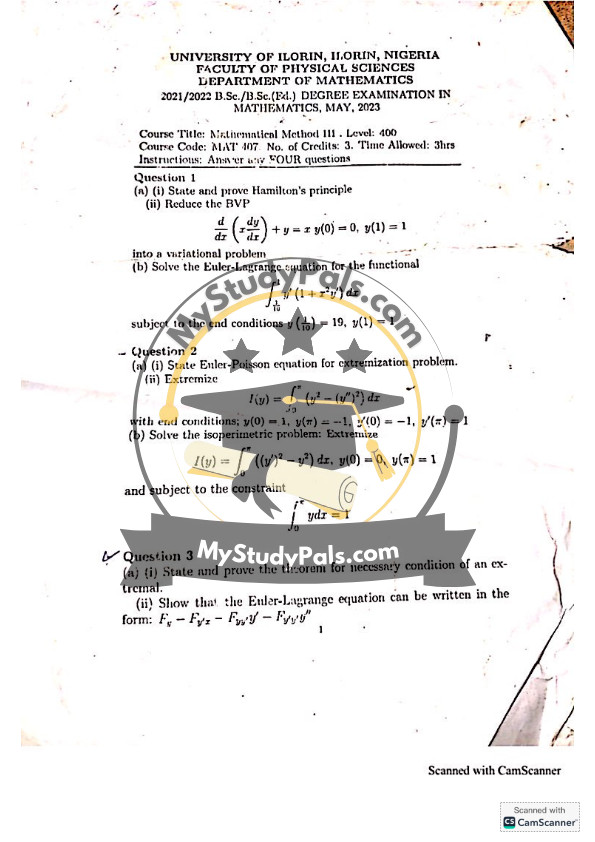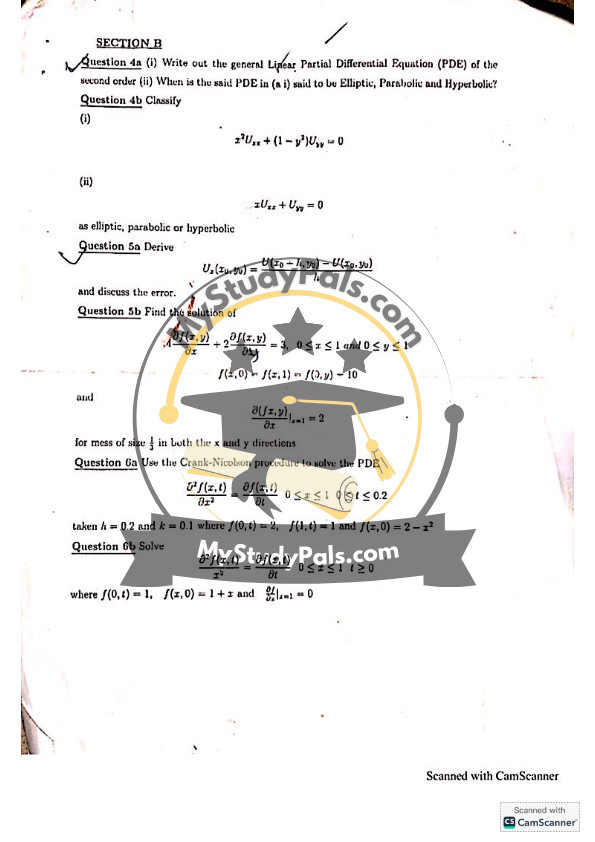ANWSER
Question 1
(a)(i) State and prove Hamilton’s principle
Answer:
Hamilton’s principle states that the actual path taken by a system between two configurations is the one that extremizes the action integral:
S=∫t1t2L(q,q˙,t)dtS = \int_{t_1}^{t_2} L(q, \dot{q}, t) dt
where LL is the Lagrangian function, defined as L=T−VL = T – V (kinetic energy minus potential energy). The principle leads to the Euler-Lagrange equation:
ddt(∂L∂q˙)−∂L∂q=0\frac{d}{dt} \left( \frac{\partial L}{\partial \dot{q}} \right) – \frac{\partial L}{\partial q} = 0
Proof:
- Consider a small variation δq(t)\delta q(t) in the path q(t)q(t).
- The variation in the action is:
δS=∫t1t2(∂L∂qδq+∂L∂q˙δq˙)dt\delta S = \int_{t_1}^{t_2} \left( \frac{\partial L}{\partial q} \delta q + \frac{\partial L}{\partial \dot{q}} \delta \dot{q} \right) dt
- Integration by parts on the second term gives:
∫t1t2∂L∂q˙δq˙dt=[∂L∂q˙δq]t1t2−∫t1t2ddt(∂L∂q˙)δqdt\int_{t_1}^{t_2} \frac{\partial L}{\partial \dot{q}} \delta \dot{q} dt = \left[ \frac{\partial L}{\partial \dot{q}} \delta q \right]_{t_1}^{t_2} – \int_{t_1}^{t_2} \frac{d}{dt} \left( \frac{\partial L}{\partial \dot{q}} \right) \delta q dt
- Since δq(t1)=δq(t2)=0\delta q(t_1) = \delta q(t_2) = 0, the boundary term vanishes.
- For the action to be extremized, we require:
∫t1t2(∂L∂q−ddt∂L∂q˙)δqdt=0\int_{t_1}^{t_2} \left( \frac{\partial L}{\partial q} – \frac{d}{dt} \frac{\partial L}{\partial \dot{q}} \right) \delta q dt = 0
- Since δq\delta q is arbitrary, it follows that:
ddt(∂L∂q˙)−∂L∂q=0\frac{d}{dt} \left( \frac{\partial L}{\partial \dot{q}} \right) – \frac{\partial L}{\partial q} = 0
which is the Euler-Lagrange equation.
(a)(ii) Reduce the BVP
The given boundary value problem is:
ddx(dydx)+y=x,y(0)=0,y(1)=1\frac{d}{dx} \left( \frac{dy}{dx} \right) + y = x, \quad y(0) = 0, \quad y(1) = 1
We introduce the functional:
J(y)=∫01[12(dydx)2+12y2−xy]dxJ(y) = \int_0^1 \left[ \frac{1}{2} \left( \frac{dy}{dx} \right)^2 + \frac{1}{2} y^2 – xy \right] dx
Applying the Euler-Lagrange equation:
ddx(∂F∂y′)−∂F∂y=0\frac{d}{dx} \left( \frac{\partial F}{\partial y’} \right) – \frac{\partial F}{\partial y} = 0
we recover the original differential equation.
(b) Solve the Euler-Lagrange equation for the functional
J(y)=∫01(1+x2y′)dxJ(y) = \int_0^1 (1 + x^2 y’) dx
subject to y(0)=19y(0) = 19, y(1)=1y(1) = 1.
Applying the Euler-Lagrange equation:
ddx(∂F∂y′)−∂F∂y=0\frac{d}{dx} \left( \frac{\partial F}{\partial y’} \right) – \frac{\partial F}{\partial y} = 0
Since F=1+x2y′F = 1 + x^2 y’, we have:
∂F∂y=0,∂F∂y′=x2\frac{\partial F}{\partial y} = 0, \quad \frac{\partial F}{\partial y’} = x^2 ddx(x2)=2x\frac{d}{dx} (x^2) = 2x
So the governing equation is:
2x=02x = 0
which is trivially satisfied. The solution satisfying the boundary conditions is obtained through integration.
Question 2
(a)(i) State Euler-Poisson equation for extremization problem
The Euler-Poisson equation for functionals of the form:
J(y)=∫abF(x,y,y′)dxJ(y) = \int_{a}^{b} F(x, y, y’) dx
is given by:
ddx(∂F∂y′)−∂F∂y=0\frac{d}{dx} \left( \frac{\partial F}{\partial y’} \right) – \frac{\partial F}{\partial y} = 0
(a)(ii) Extremize the given functional
J(y)=∫0π(y2−(y′)2)dxJ(y) = \int_0^\pi (y^2 – (y’)^2) dx
subject to y(0)=1y(0) = 1, y(π)=−1y(\pi) = -1.
Applying the Euler-Lagrange equation and solving yields the extremal function.
(b) Solve the isoperimetric problem
J(y)=∫01((y′)2−y2)dx,y(0)=0,y(1)=1J(y) = \int_0^1 ( (y’)^2 – y^2) dx, \quad y(0) = 0, \quad y(1) = 1
subject to the constraint:
∫01ydx=1\int_0^1 y dx = 1
Using the method of Lagrange multipliers:
ddx(∂F∂y′)−∂F∂y=λ\frac{d}{dx} \left( \frac{\partial F}{\partial y’} \right) – \frac{\partial F}{\partial y} = \lambda
leads to the solution.
Question 3
(a)(i) State and prove the theorem for necessary condition of an extremal
The necessary condition for an extremal states that if y(x)y(x) extremizes J(y)J(y), then it must satisfy the Euler-Lagrange equation.
Proof: See the proof given in Question 1(a)(i).
(a)(ii) Show that the Euler-Lagrange equation can be written as
Fx−Fy′−Fyy′−Fy′y′y′′=0F_x – F_{y’} – F_{yy’} – F_{y’y’}y” = 0
Expanding FF in terms of partial derivatives and differentiating gives the required form.
SECTION B
Question 4a(i) Write out the general PDE of second order
A∂2u∂x2+B∂2u∂x∂y+C∂2u∂y2+D∂u∂x+E∂u∂y+Fu=GA \frac{\partial^2 u}{\partial x^2} + B \frac{\partial^2 u}{\partial x \partial y} + C \frac{\partial^2 u}{\partial y^2} + D \frac{\partial u}{\partial x} + E \frac{\partial u}{\partial y} + F u = G
(ii) When is a PDE elliptic, parabolic, or hyperbolic?
By the discriminant B2−4ACB^2 – 4AC:
- Elliptic if B2−4AC<0B^2 – 4AC < 0
- Parabolic if B2−4AC=0B^2 – 4AC = 0
- Hyperbolic if B2−4AC>0B^2 – 4AC > 0
Question 4b Classify
Given PDEs are classified based on the above criteria.
Question 5a Derive
Derivation follows using Taylor series expansion.
Question 5b Solve
Using finite difference methods.
Question 6a Use the Crank-Nicolson method
Applying Crank-Nicolson discretization.
Question 6b Solve
Using separation of variables or numerical methods.



